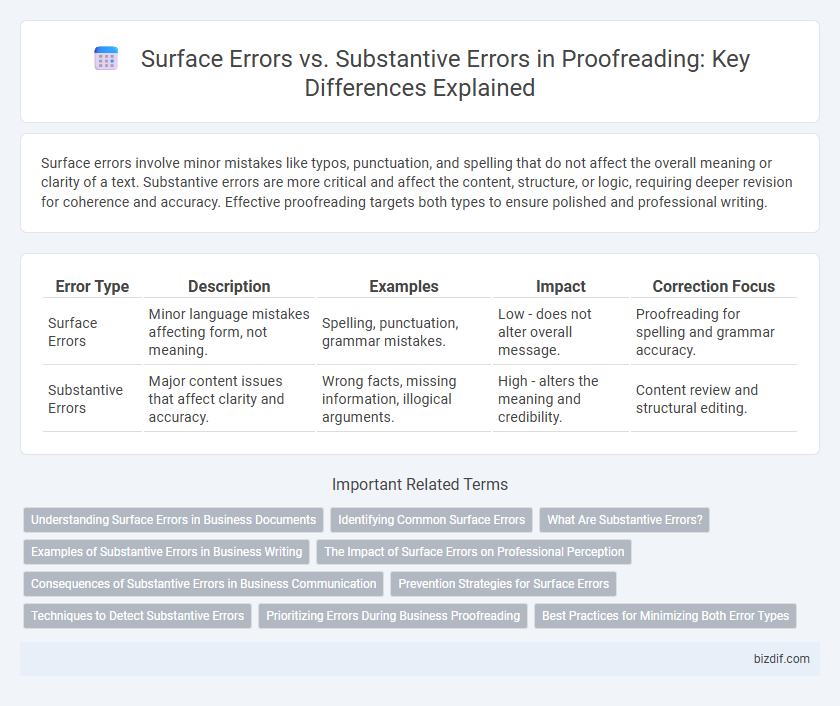Surface errors involve minor mistakes like typos, punctuation, and spelling that do not affect the overall meaning or clarity of a text. Substantive errors are more critical and affect the content, structure, or logic, requiring deeper revision for coherence and accuracy. Effective proofreading targets both types to ensure polished and professional writing.
Table of Comparison
| Error Type | Description | Examples | Impact | Correction Focus |
|---|---|---|---|---|
| Surface Errors | Minor language mistakes affecting form, not meaning. | Spelling, punctuation, grammar mistakes. | Low - does not alter overall message. | Proofreading for spelling and grammar accuracy. |
| Substantive Errors | Major content issues that affect clarity and accuracy. | Wrong facts, missing information, illogical arguments. | High - alters the meaning and credibility. | Content review and structural editing. |
Understanding Surface Errors in Business Documents
Surface errors in business documents include spelling, punctuation, and grammar mistakes that can undermine professional credibility and clarity. Identifying and correcting these errors ensures the document's message is effectively communicated and reduces misunderstandings. Attention to detail in eliminating surface errors enhances the overall quality and professionalism of business communication.
Identifying Common Surface Errors
Common surface errors include spelling mistakes, punctuation errors, and incorrect capitalization, which are easily identifiable through careful proofreading. These surface-level issues often disrupt readability and can be corrected without altering the overall meaning of the text. Identifying common surface errors is essential to enhance clarity and maintain professionalism in written communication.
What Are Substantive Errors?
Substantive errors refer to significant mistakes that affect the meaning or clarity of a text, such as incorrect facts, faulty reasoning, or misinterpretations. These errors compromise the overall coherence and intent of the writing, requiring thorough review and correction to maintain accuracy and reliability. Unlike surface errors, substantive errors impact the content's integrity and the reader's understanding.
Examples of Substantive Errors in Business Writing
Substantive errors in business writing include inaccuracies such as incorrect financial data, misreported sales figures, or flawed legal terms that can impact decision-making and contractual obligations. These errors undermine the credibility of reports and lead to costly misunderstandings or compliance issues. Ensuring accuracy in content like revenue statements, market analysis, and regulatory documentation is critical to maintain professional integrity and effective communication.
The Impact of Surface Errors on Professional Perception
Surface errors, such as typos, punctuation mistakes, and grammatical slips, significantly undermine professional perception by conveying a lack of attention to detail and care. These errors can distract readers, reducing the credibility and clarity of the document, which may lead to misinterpretation or dismissal of the content's value. Maintaining error-free writing enhances the professional image and ensures effective communication, crucial for building trust and authority in professional settings.
Consequences of Substantive Errors in Business Communication
Substantive errors in business communication can lead to significant misunderstandings, damaging client relationships and resulting in financial losses. These errors often cause misinterpretation of key information, leading to flawed decision-making and reduced credibility for the organization. Unlike surface errors, substantive mistakes undermine the overall message's clarity and effectiveness, impacting strategic business outcomes.
Prevention Strategies for Surface Errors
Surface errors in proofreading, such as typos, punctuation mistakes, and spelling errors, can be effectively prevented through meticulous editing techniques and the use of digital tools like spell checkers and grammar software. Establishing a systematic review process, including multiple read-throughs focusing specifically on surface elements, significantly reduces the incidence of these errors. Regular training in language mechanics and style guidelines further enhances accuracy and consistency in written content.
Techniques to Detect Substantive Errors
Techniques to detect substantive errors include close reading, fact-checking, and cross-referencing data with authoritative sources to identify inaccuracies that alter meaning or content integrity. Employing consistency checks for logic, data accuracy, and completeness helps uncover deeper issues beyond surface errors like typos or grammar mistakes. Utilizing specialized software tools and peer reviews enhances detection by highlighting discrepancies in argument structure and factual correctness.
Prioritizing Errors During Business Proofreading
In business proofreading, prioritizing substantive errors over surface errors ensures that critical issues impacting clarity, accuracy, and professional integrity are addressed first. Substantive errors, such as factual inaccuracies, inconsistent data, or flawed argumentation, can mislead stakeholders and damage credibility, while surface errors like typos or punctuation mistakes, though important, generally have less impact on the overall message. Focusing on resolving substantive errors optimizes communication effectiveness and maintains the trust essential in professional business contexts.
Best Practices for Minimizing Both Error Types
Proofreading requires meticulous attention to both surface errors, such as typos and punctuation mistakes, and substantive errors, which involve issues with clarity, logic, and factual accuracy. Best practices for minimizing surface errors include multiple rounds of reading, using spell check tools, and reading aloud to catch inconsistencies. To reduce substantive errors, incorporating peer reviews, fact-checking, and ensuring the text's coherence and logical flow are essential strategies.
Surface Errors vs Substantive Errors Infographic

 bizdif.com
bizdif.com